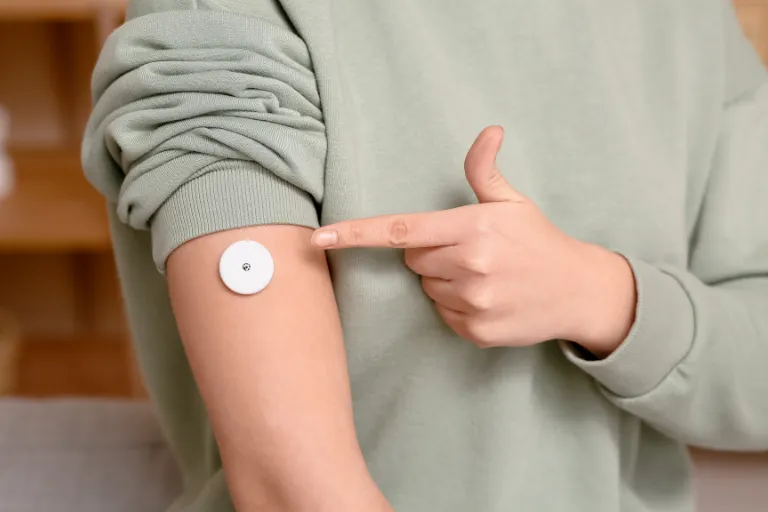Continuous glucose monitors (CGMs) were designed for people living with blood sugar regulation problems who need to track their glucose levels in real time. But over the past few years, these small wearable devices—typically worn on the upper arm or abdomen—have found a surprising new audience. Health enthusiasts, endurance athletes, and “biohackers” are now wearing CGMs even when their blood sugar is perfectly normal, hoping to gain an edge in energy, weight management, or overall metabolic health.
Is this a smart way to better understand your metabolism, or simply the latest high-tech fad? Here’s what science (and some common sense) says.
What a CGM Actually Measures
A CGM uses a tiny filament inserted just under the skin to sample interstitial fluid—the fluid that surrounds your cells. Every few minutes, it sends a glucose reading to a paired app, creating a continuous curve of your blood sugar trends.
For people with blood sugar regulation problems, that data is invaluable. It shows how meals, exercise, stress, or medication affect glucose, allowing for timely insulin adjustments and better long-term control. For someone without blood sugar regulation problems, the numbers can still reveal how different foods or habits cause temporary spikes or dips. But context matters: a brief rise after a meal is normal, and healthy bodies typically bring glucose back to baseline within two hours.
Why Healthy People Are Trying CGMs
People are drawn to CGMs for a variety of reasons beyond medical need. The most common motivations include:
- Metabolic curiosity. Many people want a personalized picture of how their body handles carbohydrates. A CGM offers more detail than an occasional fasting glucose or HbA1c test.
- Performance and recovery. Endurance athletes track glucose to fine-tune fueling during long training sessions. Seeing when levels start to drop can help prevent “bonking” or fatigue.
- Weight and appetite control. Some users say that noticing large glucose swings helps them favor lower-glycemic meals and avoid the “crash” that drives snacking.
- Early detection. A few hope continuous monitoring might flag early blood sugar regulation problems sooner than routine lab work.
These motivations are understandable—but not all are equally backed by evidence.
What the Evidence Shows (and Doesn’t)
Evidence is still limited for people without blood sugar regulation problems:
Healthy people already maintain tight control.
In individuals without blood sugar regulation problems, glucose rarely strays outside the normal range for long. Studies show that even after high-carb meals, levels typically return to baseline quickly thanks to normal insulin function.
Short-term spikes aren’t inherently harmful.
Some CGM users worry when they see post-meal readings above 140 mg/dL, but transient peaks are part of normal physiology. What matters more is overall metabolic health—fasting glucose, HbA1c, lipid profile, blood pressure, and lifestyle habits.
Lifestyle changes work without a sensor.
Balanced meals, regular exercise, adequate sleep, and stress management are proven to improve insulin sensitivity. A CGM may help with awareness, but it doesn’t replace these fundamentals.
Limited research in healthy users.
Most published studies involve people with blood sugar regulation problems or those showing early signs of such problems. Data showing improved outcomes in healthy individuals wearing CGMs are scarce.
Potential Benefits—If Used Wisely
That said, CGMs can still provide insight when interpreted correctly:
- Food patterns. You might notice that a particular breakfast spikes glucose higher than expected, prompting small adjustments like adding protein or fiber.
- Timing effects. Late-night snacks or sedentary post-meal periods often cause higher readings; a short walk can make a visible difference.
- Training feedback. For endurance sports, real-time glucose can help dial in carb intake during events.
The key is to treat the numbers as feedback, not a grade. Occasional excursions aren’t a “failure.”
Possible Downsides and Costs
Before investing in a CGM, consider these potential drawbacks:
- False alarms. Sensors can read a bit higher or lower than actual blood glucose, especially during rapid changes or in the first 24 hours of wear.
- Anxious thoughts and over-monitoring. Constant notifications can create unnecessary worry or drive restrictive eating.
- Skin irritation. Adhesive allergies or minor infections can occur at the sensor site.
- Price. In most countries, a two-week sensor costs the equivalent of USD $60–$90, and insurance rarely covers it for non-diabetics.
Professional Guidance Matters
For those considering Continuous Glucose Monitoring without a medical reason, a conversation with a qualified healthcare professional is wise. A dietitian can also help interpret readings and decide whether any patterns warrant further testing.
Smarter Ways to Support Metabolic Health
Even without a wearable device, these fundamentals have the strongest evidence for stable glucose and long-term energy levels:
- Balanced meals with fiber and protein to slow digestion and blunt spikes.
- Regular movement, including post-meal walks and both aerobic and resistance training.
- Consistent sleep and stress management improve insulin sensitivity.
- Periodic lab checks (fasting glucose, HbA1c, lipid profile) as recommended by your physician.
These habits move the needle more than any sensor alone.
Try a Data-Light First Step
Curious to see how your own meals and habits affect blood sugar?
Start with the basics: log what you eat, add a short walk after dinner, and notice how your energy changes.
If you later experiment with a CGM, share your findings with your healthcare provider so the data becomes part of a broader, personalised plan.
Bottom Line
Continuous glucose monitors can be fascinating tools, and for some athletes or data enthusiasts, they may provide actionable insights. But for most people without blood sugar regulation problems, a CGM is optional, not essential. Occasional lab tests and a focus on proven lifestyle strategies will do far more for long-term health than chasing every glucose peak on an app.
If you’re curious and can afford the cost, there’s little harm in trying a CGM for a short period—provided you approach the numbers with perspective and avoid making drastic diet changes based on a few readings.
Your metabolism is complex, and no single gadget can replace mindful eating, movement, and regular check-ups.
Medical Disclaimer: This article has been written by a licensed health professional and is intended for general informational purposes only. It does not substitute for personalised medical advice, diagnosis, or treatment. Readers should always seek the guidance of a qualified healthcare provider with any questions regarding a medical condition or health objectives. Never ignore or delay seeking medical advice based on information presented here.
Subscribe for Free for more insightful health articles tailored to your needs.
References
- Klonoff DC, Nguyen KT, Xu NY, Gutierrez A, Espinoza JC, Vidmar AP. Use of Continuous Glucose Monitors by People Without Diabetes: An Idea Whose Time Has Come? Journal of Diabetes Science and Technology. 2022;17(6):193229682211108. doi:https://doi.org/10.1177/19322968221110830
- Keshet A, Shilo S, Godneva A, et al. CGMap: Characterizing continuous glucose monitor data in thousands of non-diabetic individuals. Cell Metabolism. Published online April 17, 2023:S1550-4131(23)001298. doi:https://doi.org/10.1016/j.cmet.2023.04.002
- Wilczek F, van der Stouwe JG, Petrasch G, Niederseer D. Non-Invasive Continuous Glucose Monitoring in Patients Without Diabetes: Use in Cardiovascular Prevention—A Systematic Review. Sensors. 2025;25(1):187. doi:https://doi.org/10.3390/s25010187
- Spartano NL, Sultana N, Lin H, et al. Defining continuous glucose monitor time in range in a large community-based cohort without diabetes. The Journal of Clinical Endocrinology & Metabolism. Published online September 11, 2024. doi:https://doi.org/10.1210/clinem/dgae626
- Anderson JE, Gavin JR, Kruger DF. Current Eligibility Requirements for CGM Coverage Are Harmful, Costly, and Unjustified. Diabetes Technology & Therapeutics. 2020;22(3):169-173. doi:https://doi.org/10.1089/dia.2019.0303




